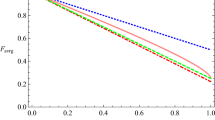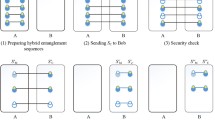Abstract
Recently, Hwang et al. (Eur. Phys. J. D 61:785, 2011) and Yuan et al. (Int. J. Theor. Phys. 50:2403, 2011) have proposed two efficient protocols of secure quantum communication using 3-qubit and 4-qubit symmetric W state respectively. These two dense coding based protocols are generalized and their efficiencies are considerably improved. Simple bounds on the qubit efficiency of deterministic secure quantum communication (DSQC) and quantum secure direct communication (QSDC) protocols are obtained and it is shown that dense coding is not essential for designing of maximally efficient DSQC and QSDC protocols. This fact is used to design maximally efficient protocols of DSQC and QSDC using 3-qubit and 4-qubit W states.
Similar content being viewed by others
Notes
Since in this type of protocols Alice needs to announce exact sequence (classical information) so these are examples of DSQC.
The authors had claimed it as a QSDC protocol but it is actually a DSQC protocol since Bob needs the measurement outcomes of Alice’s measurement to decode the classical information encoded by Alice.
When 2x qubits (a random mix of message qubits and decoy qubits) travel through a channel accessible to Eve and x of them are test for eavesdropping then for any δ>0, the probability of obtaining less than δn errors on the check qubits (decoy qubits), and more than (δ+ϵ)n errors on the remaining x qubits is asymptotically less than exp[−O(ϵ 2 x)] for large x [28]. As the unconditional security obtained in quantum cryptographic protocol relies on the fact that any attempt of Eavesdropping can be identified. Thus to obtain an unconditional security we always need to check half of travel qubits for eavesdropping. Thus we have to randomly add decoy qubits whose number would be equal to the total number of travel qubits.
The original protocol is insecure as Eve can obtain substantial amount of information before being detected. Inclusion of rearrangement of particle ordering can make the protocol secure. But that would increase the amount of classical communication and consequently decrease the efficiency.
References
Bennett, C.H., Brassard, G.: In: Proceedings of the IEEE International Conference on Computers, Systems, and Signal Processing, Bangalore, p. 175 (1984)
Ekert, A.K.: Phys. Rev. Lett. 67, 661 (1991)
Bennett, C.H.: Phys. Rev. Lett. 68, 3121 (1992)
Long, G., et al.: Front. Phys. China 2, 251 (2007)
Shimizu, K., Imoto, N.: Phys. Rev. A 60, 157 (1999)
Hillery, M., Buzek, V., Bertaiume, A.: Phys. Rev. A 59, 1829 (1999)
Bostrom, K., Felbinger, T.: Phys. Rev. Lett. 89, 187902 (2002)
Goldenberg, L., Vaidman, L.: Phys. Rev. Lett. 75, 1239 (1995)
Lucamarini, M., Mancini, S.: Phys. Rev. Lett. 94, 140501 (2005)
Cai, Q.Y., Li, B.W.: Phys. Rev. A 69, 054301 (2004)
Deng, F.G., Long, G.L., Liu, X.S.: Phys. Rev. A 68, 042317 (2003)
Deng, F.G., Long, G.L.: Phys. Rev. A 68, 042315 (2003)
Zhu, A.D., Xia, Y., Fan, Q.B., Zhang, S.: Phys. Rev. A 73, 022338 (2006)
Yuan, H., et al.: Int. J. Theor. Phys. 50, 2403 (2011)
Tsai, C.W., Hsieh, C.R., Hwang, T.: Eur. Phys. J. D 61, 779 (2011)
Zhao, G., et al.: Procedia Eng. 29, 568 (2012)
Hwang, T., Hwang, C.C., Tsai, C.W.: Eur. Phys. J. D 61, 785 (2011)
Wang, M.Y., Yan, F.L.: Chin. Phys. B 20, 120309 (2011)
Pradhan, B., Agrawal, P., Pati, A.K.: (2007). arXiv:0705.1917v1 [quant-ph]
Cabello, A.: Phys. Rev. Lett. 85, 5635 (2000)
Tsai, C.W., Hwang, T.: Opt. Commun. 283, 4397 (2010)
Wang, X.W.: Quantum Inf. Process. 8, 431 (2009)
Cao, H.J., Song, H.S.: Chin. Phys. Lett. 23, 290 (2006)
Wang, J., Zhang, Q., Tang, C.J.: Commun. Theor. Phys. (Beijing, China) 48, 637 (2007)
Dong, L., et al.: Commun. Theor. Phys. 50, 359 (2008)
Yaun, H., et al.: Commun. Theor. Phys. 55, 984 (2011)
Banerjee, A., Pathak, A.: Phys. Lett. A (2012). doi:10.1016/j.physleta.2012.08.032
Nielsen, M.A., Chuang, I.L.: Quantum Computation and Quantum Information, p. 589. Cambridge University Press, New Delhi (2008)
Eible, M., et al.: Phys. Rev. Lett. 92, 077901 (2004)
Yao, X.-C., et al.: Phys. Rev. Lett. 105, 120402 (2010)
Acknowledgement
AP thanks Department of Science and Technology (DST), India for support provided through the DST project No. SR/S2/LOP-0012/2010 and the Ministry of Education of the Czech Republic for support provided through the project CZ.1.05/2.1.00/03.0058.
Author information
Authors and Affiliations
Corresponding author
Rights and permissions
About this article
Cite this article
Shukla, C., Banerjee, A. & Pathak, A. Improved Protocols of Secure Quantum Communication Using W States. Int J Theor Phys 52, 1914–1924 (2013). https://doi.org/10.1007/s10773-012-1311-7
Received:
Accepted:
Published:
Issue Date:
DOI: https://doi.org/10.1007/s10773-012-1311-7




